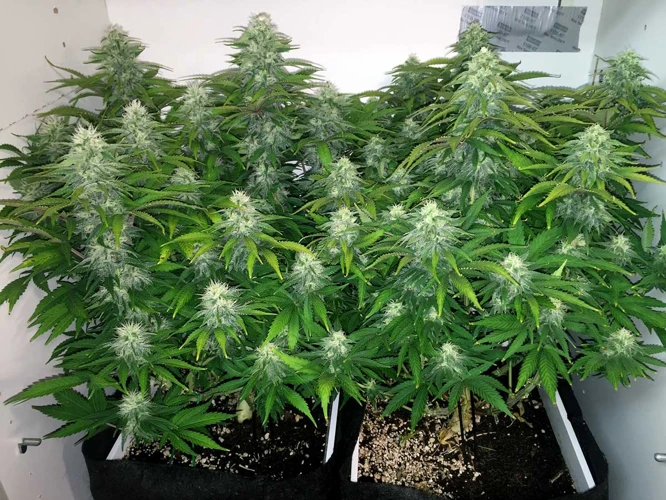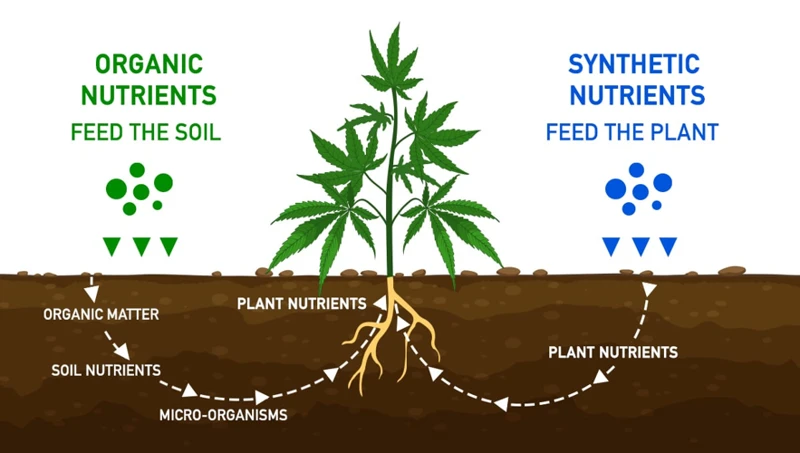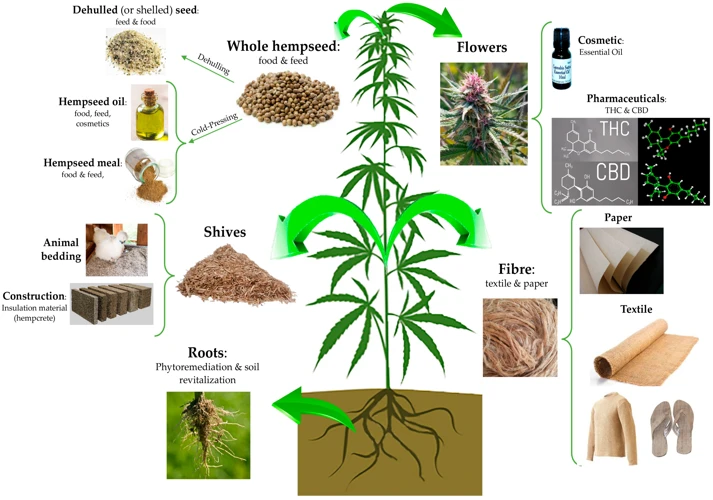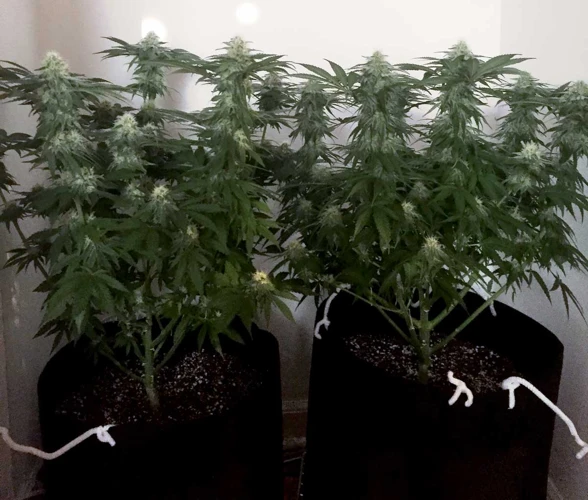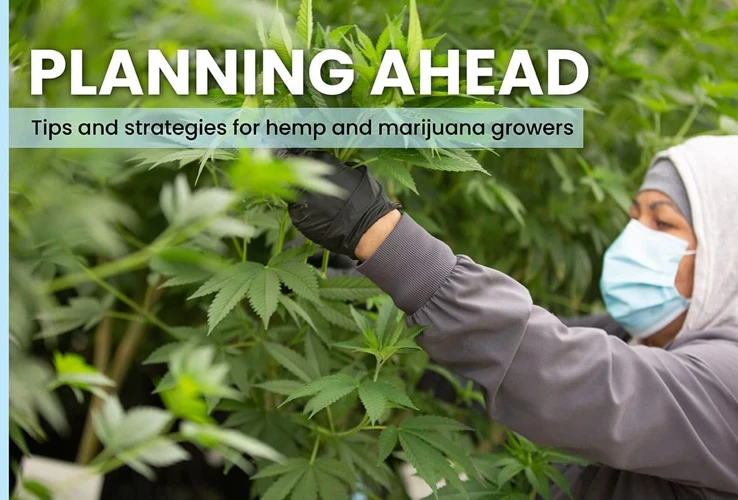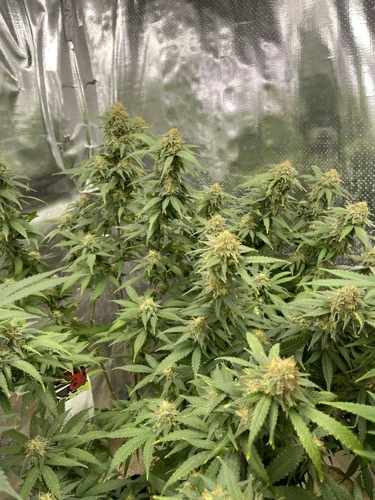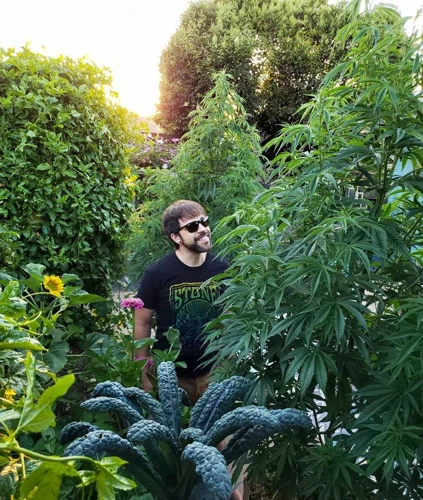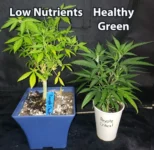
Organic vs Synthetic Nutrients for Cannabis Buds
As the cannabis industry continues to grow, so does the debate on whether to use organic or synthetic nutrients to cultivate the best possible buds. Each option has its own set of advantages and disadvantages, and it’s not always clear which one offers a better taste profile. With so much conflicting information out there, it can be difficult to determine which option is right for your growing needs. In this article, we’ll dive into the differences between organic and synthetic nutrients, explore their effects on taste profile, and provide our recommendations on which one to choose for various types of growing operations.
What Are Organic Nutrients?
Contents
As a cannabis grower, you have a choice when it comes to nutrients: organic or synthetic. But for some, the question remains, what exactly are organic nutrients? Fret not, as we delve into this topic with meticulous detail. Organic nutrients are derived from natural substances – think composted plant and animal matter – that provide essential minerals and nutrients to the plant. This method of nourishment is considered to be the “old-fashioned” way of growing, but it has recently experienced a resurgence in popularity due to its perceived health benefits. Let’s explore the advantages and disadvantages of using organic nutrients for cultivating cannabis.
Advantages of Organic Nutrients
Organic nutrients have become increasingly popular among cannabis growers due to their numerous benefits. These advantages include:
- Improved Taste and Aroma: Organic nutrients contain natural ingredients that can enhance the taste and aroma of cannabis buds. This is because organic nutrients help to create a more complex flavor profile, with subtle and nuanced flavors.
- Better for the Environment: Organic nutrients are made using natural ingredients, making them a more environmentally-friendly alternative to synthetic nutrients. They are biodegradable and do not leave any harmful residues in the soil.
- Slow-Release: Organic nutrients are typically slow-release, meaning that the nutrients are released over time as the soil decomposes. This ensures that the plant gets a steady supply of nutrients, minimizing the risk of nutrient burn or over-feeding.
- Less Risk of Nutrient Lockout: Organic nutrients are less likely to cause nutrient lockout, a condition that occurs when the plant is unable to absorb nutrients due to an excess of other nutrients or pH imbalance in the soil. This is because organic nutrients tend to have a more balanced nutrient profile.
- Improved Soil Health: Organic nutrients can improve the overall health of the soil by promoting the growth of beneficial organisms such as bacteria and fungi. These organisms help to break down organic matter, creating a healthy and nutrient-rich environment for the plant.
Organic nutrients can be a great choice for cannabis growers who are looking for a natural and sustainable way to grow their plants while also enhancing the taste and aroma of their buds.
Disadvantages of Organic Nutrients
While organic nutrients have many advantages, they are not without their disadvantages. Below are some of the limitations of using organic nutrients for growing cannabis.
- Slow-Release: One of the most significant downsides of organic nutrients is that they tend to be slow-release, meaning that plants may not receive the necessary nutrients as quickly as they would with synthetic nutrients.
- Inconsistency: Organic nutrients can also be inconsistent in their nutrient content. Depending on the quality of the soil or compost used, the nutrient levels in organic fertilizers can vary significantly from batch to batch.
- Potential for Contamination: Since organic nutrients are made from natural sources, there is a risk of contamination from harmful chemicals, pesticides, and other pollutants that may be present in the soil or compost used.
- Higher Cost: Organic fertilizers tend to be more expensive than synthetic fertilizers, mainly because of the time and effort required in their production.
- Slower Growth: Organic nutrients tend to promote slower growth compared to synthetic nutrients, which can lead to longer grow times and smaller yields.
It’s essential to consider these limitations when deciding whether to use organic nutrients for growing cannabis. While they offer many benefits, they may not be the best option for every grower or every situation. Ultimately, the choice between organic and synthetic nutrients comes down to personal preference, budget, and other factors specific to each grower’s needs.
What Are Synthetic Nutrients?
When it comes to cannabis cultivation, there are two main types of nutrients that growers use to help their plants thrive: organic and synthetic. While we’ve already covered the benefits and drawbacks of organic nutrients, it’s time to explore the sometimes controversial world of synthetic nutrients. Synthetic nutrients, also known as chemical nutrients, are man-made and are designed to provide a plant’s basic nutritional needs without any organic matter. But what exactly are synthetic nutrients, and how do they differ from organic ones? Let’s take a closer look.
Advantages of Synthetic Nutrients
When it comes to synthetic nutrients, there are several advantages that make them appealing to many cannabis growers. These advantages include:
| Advantages of Synthetic Nutrients | |
| Consistency: | Synthetic nutrients are formulated to provide a consistent blend of nutrients that are readily available to the plant. This makes it easier to dial in the exact amount of nutrients the plant needs for optimal growth. |
| Cost-effectiveness: | Synthetic nutrients are generally less expensive than organic nutrients, which makes them an attractive option for those on a budget. |
| Fast-acting: | Synthetic nutrients are designed to be quickly absorbed by the plant, which means they can provide fast results in terms of growth and yield. |
| Easy to use: | Synthetic nutrients are often sold as pre-mixed solutions or powders that are easy to measure and apply. This makes them a convenient option for growers who want to simplify their growing process. |
| No composting required: | Unlike organic nutrients, synthetic nutrients do not require composting or other forms of organic matter to be added to the soil. This can save time and effort for growers. |
While these advantages make synthetic nutrients an attractive option for many growers, it is important to consider the potential drawbacks as well. Some of the disadvantages of synthetic nutrients include their impact on the environment and the potential for nutrient buildup in the soil. It is important for growers to weigh both the pros and cons before making a decision on whether to use synthetic nutrients for growing cannabis.
Disadvantages of Synthetic Nutrients
Synthetic nutrients have their own set of disadvantages as compared to organic nutrients, despite being a popular choice among commercial growers. Here are some of the drawbacks associated with synthetic nutrients:
| Disadvantages of Synthetic Nutrients |
| 1. Environmental concerns: Synthetic fertilizers can lead to environmental damage. When synthetic nutrients are used, excess salts and chemicals are released into the soil, damaging the ecosystem. |
| 2. Risk of overfeeding: Synthetic nutrients are highly concentrated, and they are easy to overfeed. If plants are overfed with synthetic nutrients, it can leading to nutrient burn and affect their growth adversely. |
| 3. Incomplete nutrition: Synthetic nutrients can be beneficial in the rapid growth of plants, but they offer an incomplete nutrition profile. Growers often need to supplement micronutrients and beneficial bacteria, which can add to the cost. |
| 4. Negative effects on taste and aroma: Synthetic nutrients can have a negative impact on the taste and aroma of cannabis buds. The chemicals and salts present in synthetic fertilizers can leave an aftertaste, which can be undesirable for consumers. |
It is important to keep in mind that while synthetic nutrients may offer some benefits, they also come with a set of concerns. Growers should weigh the pros and cons carefully before deciding on which type of nutrients to use. Understanding the environmental impact, risk of overfeeding, incomplete nutrition, and impact on taste and aroma is essential when making a choice between organic and synthetic nutrients.
Taste Profile of Organic vs Synthetic Cannabis Buds
The taste profile of cannabis buds can be influenced by the type of nutrients used during the growing process. Organic nutrients are derived from natural substances such as bone meal, fish emulsion, and compost. They are generally considered to produce a superior taste profile in cannabis buds, as they are more likely to contain a wider range of micronutrients and trace elements. This can lead to a more complex and nuanced flavor profile in the finished product.
Synthetic nutrients, on the other hand, are made from chemical compounds and are designed to provide plants with a precise balance of nutrients in a form that is easily absorbed. While they can produce large yields and a consistent flavor, some argue that synthetic nutrients can also produce a “chemical” taste in the finished product.
It is important to note that the taste profile of cannabis buds is subjective and can vary greatly depending on a variety of factors, including genetics, environment, and curing process. The choice between organic and synthetic nutrients should not be based solely on taste, but rather on a range of factors, including grower experience, personal preference and availability.
Factors That Affect Taste Profile
There are several important factors that can influence the taste profile of your cannabis buds. One of the most important is genetics. Different strains of cannabis have different terpene profiles, which can affect both the aroma and the flavor of the finished product. Selecting a strain with desirable flavor characteristics can go a long way in achieving a great tasting end result.
The environment in which the plant is grown can also have a significant impact on taste. This includes factors like temperature, humidity, lighting, and air circulation. For example, higher levels of humidity can promote the growth of mold and mildew, which can cause off flavors and aromas in the finished product.
The harvesting and curing process is another important consideration. Improperly harvested or cured buds can develop a “grassy” or “hay-like” taste, while a well-cured bud can have a smooth, complex flavor profile. Proper drying and curing also helps to preserve terpenes, which are a major contributor to taste and aroma.
Organic vs Synthetic Nutrients: Which Should You Choose?
Choosing between organic and synthetic nutrients ultimately comes down to personal preference and the specific needs of your grow. For growing for personal use, organic nutrients may be a more attractive option due to their perceived benefits for taste and overall quality. However, organic nutrients can be more difficult to find and may require more skill and experience to use effectively.
Commercial growing operations may prefer to use synthetic nutrients, as they are often easier to use and can produce larger yields. Additionally, commercial growers may be less concerned with taste and more focused on producing a consistent end product that meets consumer demand.
Using Organic and Synthetic Nutrients Together
Using a combination of organic and synthetic nutrients, also known as “hybrid” growing, can offer benefits over using either type of nutrient alone. This approach can provide plants with a wider range of nutrients and the benefits of both organic and synthetic nutrients. However, there are pros and cons to using this method.
Pros of hybrid growing include increased flexibility and fine-tuning of the nutrient regimen, which can lead to improved plant growth without sacrificing taste or quality.
Cons of hybrid growing include the potential for nutrient lockout, which can limit the plant’s ability to absorb nutrients properly. Additionally, organic and synthetic nutrients may interact with each other in unpredictable ways, potentially leading to imbalances in the nutrient regimen.
Best Practices for Using Organic and Synthetic Nutrients
When using a combination of organic and synthetic nutrients, it is important to follow best practices to ensure the best possible results. This includes carefully measuring and monitoring nutrient levels, pH levels, and water quality, as well as paying close attention to plant health and development.
Additionally, it is recommended to start with a simple nutrient regimen and gradually increase complexity as needed. This can help to minimize the risk of nutrient imbalances and other potential problems.
Tips for Maximizing Taste Profile in Cannabis Buds
To maximize the taste profile of your cannabis buds, it is important to pay attention to factors such as strain selection, environment, and harvesting and curing process. Additionally, using high-quality nutrients and following best practices for nutrient management can also lead to improved taste.
It is also important to properly store your cannabis buds after harvest to maintain flavor and potency. This includes storing buds in a cool, dark place and using airtight containers to help protect against exposure to air and moisture.
Conclusion
While the choice between organic and synthetic nutrients may ultimately depend on personal preference and growing goals, there is no doubt that the taste profile of cannabis buds is a complex and multifaceted topic. By paying close attention to factors such as genetics, environment, and nutrient management, growers can help to produce buds with a delicious and complex flavor profile that is sure to be enjoyed by all.
Factors That Affect Taste Profile
When it comes to the taste of cannabis buds, there are several factors that can affect their overall flavor profile. Understanding these variables is crucial for growers seeking to cultivate the most delicious buds possible. From genetics to environment to the harvesting and curing process, each of these elements plays a critical role in determining the aroma, taste, and quality of the cannabis plant. Let’s explore the most significant factors that can impact the taste profile of cannabis buds.
Genetics
The taste profile of cannabis buds is heavily influenced by genetics. Each strain has its unique combination of terpenes, which are responsible for the aroma and flavor of the plant. Some strains are bred specifically for their taste, while others may focus on potency or yield. It is important to choose a strain that is known for its flavor if taste is a top priority.
Here are some genetic factors that can affect the taste profile:
- Terpene content: As mentioned, terpenes are the primary source of flavor in cannabis. Some strains have higher levels of certain terpenes, which can result in a stronger taste profile. For example, strains like Blueberry and Grapefruit are known for their fruity taste due to their high levels of the terpenes myrcene and limonene, respectively.
- Harvest time: The timing of the harvest can greatly influence the taste profile of the buds. Some strains are best harvested earlier, while others need more time to fully develop their flavor. Harvesting too early can result in buds that taste harsh and unripe, while waiting too long can lead to a more mellower flavor.
- Growing conditions: The environment in which the plants are grown can also impact their taste. Factors like temperature, humidity, and light can all affect the development of terpenes and cannabinoids that give the plant its taste profile. Ideally, cannabis should be grown in a controlled environment to ensure consistent and optimal conditions for the best taste results.
- Growing techniques: The techniques used to grow cannabis can also impact its taste. For example, plants grown using organic nutrients may have a more earthy taste compared to those grown using synthetic nutrients, which may have a more chemical-like taste. Similarly, plants that have been properly flushed of nutrients before harvesting may have a cleaner taste than those that have been treated with chemical nutrients right up until the end.
Understanding the role genetics play in the taste profile of cannabis is just one aspect of producing buds with a great taste. In addition to genetics, growers must also pay attention to the overall environment, harvesting and curing process, and the nutrients used to grow the plants to ensure that they produce the best tasting buds possible.
Environment
The environment in which cannabis is grown plays a significant role in the taste profile of the buds. In particular, factors such as temperature, humidity, and light can greatly impact the overall flavor and aroma of the final product.
Temperature: Cannabis plants thrive in a temperature range of 60-85°F (15-29°C), with the sweet spot being around 70°F (21°C). If the temperature is consistently too hot or too cold, it can lead to stress and affect the development of terpenes, which are responsible for the unique aroma and flavor of the buds.
Humidity: Proper humidity levels are crucial for cannabis cultivation. During the vegetative stage, humidity should be around 50-70%, while during the flowering stage, it should be between 40-50%. If the humidity is too high, it can lead to mold and mildew growth, which can impact the flavor and overall quality of the buds.
Light: Light exposure can also affect the taste profile of cannabis buds. Too much light can cause stress and result in the development of a harsh or bitter taste, while too little light can lead to a lack of flavor and aroma.
It’s worth noting that environmental factors are closely intertwined, and a balance must be struck to achieve optimal taste profiles in cannabis buds. Growers must pay close attention to all factors and adjust them as necessary to ensure a high-quality final product.
Here’s a table summarizing the impact of environment on taste profile:
| Environmental Factor | Effect on Taste Profile |
|---|---|
| Temperature | Impacts development of terpenes |
| Humidity | Improper levels can lead to mold and mildew growth |
| Light | Too much or too little can impact flavor and aroma |
Harvesting and Curing Process
Harvesting and Curing Process
The harvesting and curing process can have a significant impact on the taste profile of cannabis buds, regardless of whether they were grown using organic or synthetic nutrients.
Harvesting
Harvesting cannabis buds involves carefully cutting the mature buds from the plant. This process should be done in the morning when the plant’s nutrient content is at its highest. It’s important to avoid damaging the buds during the harvesting process as this can affect the overall taste.
Curing
Once harvested, the buds must go through a curing process before they can be consumed. This involves drying the buds in a controlled environment for a period of several weeks. During this time, excess moisture is removed from the buds, and natural chemical changes take place that can impact the final taste.
Factors Affecting Curing
There are several factors that can affect the quality of the curing process, including temperature, humidity, air circulation, and the initial drying process. It’s important to monitor these factors closely to ensure the buds are properly cured.
Temperature
The ideal temperature for curing cannabis buds is between 60-70°F (15-21°C). Higher temperatures can cause the buds to dry out too quickly, while cooler temperatures can slow down the curing process.
Humidity
The ideal humidity level for the curing process is between 50-60%. Too high humidity can cause fungal growth, while too low humidity can cause the buds to dry out too quickly.
Air Circulation
Proper air circulation is important to prevent mold growth and ensure even drying of the buds. Fans or other air-moving devices can be used to achieve this.
Initial Drying Process
The initial drying process, or “drying down,” involves removing excess moisture from the buds before they are cured. This process should be done slowly, over a period of 7-10 days, to avoid damaging the buds.
Testing for Proper Curing
To test whether the buds are properly cured, gently squeeze a bud between your fingers. It should feel slightly firm but still somewhat spongy. If the bud feels too dry or too moist, additional curing time may be necessary.
The proper harvesting and curing process can have a significant impact on the taste profile of cannabis buds, regardless of the type of nutrients they were grown with. It’s important to pay close attention to these factors to ensure the buds are of the highest quality.
Organic vs Synthetic Nutrients: Which Should You Choose?
One of the biggest decisions when it comes to growing cannabis is choosing between organic and synthetic nutrients. There are pros and cons to each option, and the decision ultimately depends on your goals and preferences. In this section, we will explore the factors to consider when deciding between organic and synthetic nutrients, as well as provide recommendations for different types of growers. By the end, you will have the information needed to make an informed decision and choose the nutrient option that is best for you and your cannabis plants.
Growing for Personal Use
When it comes to growing cannabis for personal use, there are several factors to consider in choosing between organic and synthetic nutrients. Here are some considerations:
- Growing experience: If you are an experienced grower with a green thumb, then organic nutrients may be a good choice for you. However, if you are just starting out, synthetic nutrients may be more forgiving, as they provide more precise control over nutrient levels and pH.
- Budget: Organic nutrients tend to be more expensive than synthetic nutrients. If you are on a tight budget, synthetic nutrients may be the more practical choice.
- Taste preferences: If you place a premium on taste and aroma, organic nutrients may be the better option. Although synthetic nutrients can produce high yields, they may not deliver the same depth of flavor and aroma that organic nutrients can.
- Environmental concerns: If you are concerned about the environmental impact of your growing practices, organic nutrients may be the more responsible choice. Synthetic nutrients often contain chemicals that can be harmful to the environment, whereas organic nutrients are derived from natural sources.
- Personal beliefs: If you have personal beliefs around organic and sustainable farming practices, then organic nutrients may align better with your values. Additionally, some people prefer to consume organic cannabis for health reasons.
Ultimately, the choice between organic and synthetic nutrients for personal use will depend on your individual priorities and circumstances. It may be worthwhile to experiment with both and see which yields better results for you.
Commercial Growing Operations
Commercial Growing Operations:
In large-scale commercial growing operations, the choice of nutrient option largely comes down to efficiency and cost-effectiveness. Synthetic nutrients tend to be more popular due to their consistency and the fact that they can be tailored to meet the specific needs of the plants. Additionally, synthetic nutrients tend to have a longer shelf life and are less susceptible to bacterial growth, which is important in large-scale operations where contamination can result in significant financial losses.
However, organic nutrients are becoming increasingly popular in commercial operations as consumers have shown a greater preference for organic products. This has led to an increase in the demand for organic cannabis, which has a higher price point and greater profit margin. Many commercial growers are opting for organic nutrients in their operations, despite the higher cost and generally lower yield compared to synthetic nutrients.
Below is a comparison table of the advantages and disadvantages of organic and synthetic nutrients in commercial growing operations:
| Organic Nutrients | Synthetic Nutrients |
|---|---|
| +Higher profit margin for organic cannabis | +Consistent, tailored nutrient options |
| +Higher demand for organic cannabis | +Longer shelf life |
| -Higher cost | -Higher risk of bacterial growth |
| -Generally lower yield compared to synthetic nutrients | -May lack certain micronutrients found in organic options |
Ultimately, the choice between organic and synthetic nutrients in commercial operations comes down to the specific goals and priorities of the grower. While synthetic nutrients may provide a more efficient and consistent option, organic nutrients may bring in a higher profit margin and greater demand from consumers seeking organic products. Regardless of the chosen nutrient option, it’s important for commercial growers to prioritize maximizing taste profile in their cannabis buds to meet the expectations of their customers.
Commonly Used Organic Nutrients for Cannabis
Many growers opt for organic nutrients when cultivating cannabis, as they believe it provides a more natural and flavorful product. Here are some commonly used organic nutrients for cannabis:
Bat Guano: Bat guano is one of the most popular organic fertilizers among cannabis growers. It is rich in nitrogen, phosphorus, and potassium, making it a great all-around fertilizer. It also contains beneficial microorganisms that help promote healthy plant growth.
Earthworm Castings: Earthworm castings are a type of organic fertilizer made from the excrement of earthworms. They are rich in nutrients and minerals, including nitrogen, phosphorus, and potassium. They also contain beneficial microbes that can help improve soil structure and nutrient uptake.
Bone Meal: Bone meal is a type of organic fertilizer made from ground animal bones. It is high in phosphorus, which is essential for healthy root development and flower production. Bone meal also contains calcium, which helps maintain strong cell walls and supports overall plant health.
Compost: Compost is a mixture of organic matter that has been decomposed by microorganisms. It is rich in nutrients, including nitrogen, phosphorus, and potassium, and can help improve soil structure and water retention. Compost can also be used as a soil amendment to help maintain pH balance.
Fish Emulsion: Fish emulsion is a liquid fertilizer made from fish waste. It is high in nitrogen, making it a great choice for promoting vegetative growth. Fish emulsion is also beneficial for promoting healthy soil microbes and improving soil structure.
It’s worth noting that using organic nutrients does require more attention to detail and preparation, as they can be more difficult to measure and regulate compared to synthetic nutrients. However, many growers believe the added effort is worth it, as organic nutrients can provide a more flavorful and natural cannabis product.
Commonly Used Synthetic Nutrients for Cannabis
Synthetic nutrients have become increasingly popular in recent years as an alternative to organic nutrients. They are manufactured from chemical compounds and are designed to provide plants with the essential nutrients needed for optimal growth and yield. Here are some of the commonly used synthetic nutrients for cannabis cultivation.
Nitrogen (N): Nitrogen is an essential macronutrient that is responsible for the plant’s vegetative growth. Synthetic nitrogen fertilizers are highly soluble and provide the plant with a quick boost of nitrogen. However, excessive use can lead to nitrogen burn, which can result in stunted growth and burnt leaves.
Phosphorus (P): Phosphorus is critical for the plant’s root development, photosynthesis, and flower formation. Synthetic phosphorus fertilizers are highly soluble and provide fast absorption by the plant. However, excessive use can lead to the accumulation of salts in the soil, which can harm the roots and lead to nutrient deficiencies.
Potassium (K): Potassium is essential for the plant’s overall health and helps regulate water uptake and nutrient transport. Synthetic potassium fertilizers are highly soluble and provide a quick boost of potassium to the plant. However, excessive use can lead to potassium toxicity, which can result in poor yields, stunted growth, and burnt leaves.
Calcium (Ca): Calcium is critical for the plant’s cellular structure, growth, and metabolism. Synthetic calcium fertilizers are highly soluble and provide the plant with a quick boost of calcium. However, excessive use can lead to a buildup of calcium in the soil, which can lead to nutrient deficiencies and pH imbalances.
Magnesium (Mg): Magnesium is necessary for the plant’s photosynthesis, metabolism, and enzyme production. Synthetic magnesium fertilizers are highly soluble and provide a quick boost of magnesium to the plant. However, excessive use can lead to magnesium toxicity, which can result in poor yields, stunted growth, and leaf burn.
Sulfur (S): Sulfur is essential for the plant’s metabolism and protein production. Synthetic sulfur fertilizers are highly soluble and provide a quick boost of sulfur to the plant. However, excessive use can lead to pH imbalances and nutrient deficiencies in the soil.
When using synthetic nutrients, it is crucial to follow the manufacturer’s instructions carefully and avoid overfeeding the plants. Too much of a good thing can have negative effects on the plant and ultimately impact the taste and quality of the buds.
Using Organic and Synthetic Nutrients Together
Cannabis growers often find themselves in a dilemma when choosing between organic and synthetic nutrients for their plants. While both options have their advantages and disadvantages, some growers prefer to use a combination of the two. The idea is to reap the benefits of both types of nutrients and minimize their drawbacks. But how effective is it to use organic and synthetic nutrients together? In this section, we explore the pros and cons of such an approach and delve into the best practices to maximize the taste profile of your cannabis buds.
Pros
When it comes to using both organic and synthetic nutrients together, there are several potential benefits to consider. Here are some of the pros:
- Increased Nutrient Availability: When using a combination of organic and synthetic nutrients, plants have access to a wider range of nutrients than when using one type of nutrient exclusively. This can lead to better growth and development of the plant overall.
- Customizable Nutrient Formulas: By using a combination of organic and synthetic nutrients, growers can create custom nutrient formulas to address specific issues or deficiencies within their plants. This can help to improve plant health and yield.
- Balanced Nutrient Ratios: Organic and synthetic nutrients often have different nutrient ratios. By using both, growers can achieve a more balanced nutrient ratio for their plants, which can lead to better overall growth and production.
- Improved Taste Profile: Using both organic and synthetic nutrients can help to improve the taste profile of cannabis buds. This is because the plants have access to a wider range of nutrients, which can impact the flavor and aroma of the final product.
- Increased Yield: By using a combination of organic and synthetic nutrients, growers may be able to achieve higher yields than with either nutrient type alone. This is because the plants have access to a wider range of nutrients, which can enhance their growth and production.
While there are certainly potential benefits to using both organic and synthetic nutrients together, there are also some cons to consider. These can include:
- Increased Complexity: Using a combination of organic and synthetic nutrients can be more complex than using one type of nutrient exclusively. Growers may need to monitor nutrient ratios more closely or adjust their nutrient formulas more frequently to achieve optimal results.
- Increased Expense: Using both organic and synthetic nutrients together can be more expensive than using one type of nutrient alone. This is because growers will need to purchase both types of nutrients, as well as any additional supplements needed to create their custom nutrient formulas.
- Potential for Nutrient Imbalances: When using a combination of organic and synthetic nutrients, there is greater potential for nutrient imbalances to occur. This is because different nutrients may be absorbed at different rates or in different ways, which can impact the overall nutrient ratio of the plant.
While there are both pros and cons to using a combination of organic and synthetic nutrients, growers may find that this approach is beneficial when trying to achieve specific goals with their cannabis plants. However, it is important to carefully monitor nutrient ratios and make adjustments as needed to avoid potential nutrient imbalances.
Cons
One of the drawbacks of using both organic and synthetic nutrients together is the risk of nutrient lockout. This occurs when certain nutrients become unavailable to the plant because they are bound to other nutrients or minerals in the soil. It can be difficult to diagnose and correct nutrient lockout, as it can present symptoms similar to other nutrient deficiencies.
Over-fertilization can also occur when using both organic and synthetic nutrients together, as they can interact in unexpected ways and lead to a buildup of salts in the soil. This can cause toxicity in the plant and negatively impact the taste profile of the buds.
Another challenge when using both organic and synthetic nutrients is finding the right balance between the two. The plant may respond differently to each type of nutrient, and finding the right ratio can be a trial-and-error process that requires close monitoring of the plant’s growth and development.
Cost is also a factor to consider when using both organic and synthetic nutrients, as the expense of purchasing both types of fertilizers can add up. Additionally, the additional time and effort required to properly mix and apply the nutrients can also add to the overall cost and labor required for the growing operation.
Lastly, the use of both organic and synthetic nutrients can make it harder to achieve consistency in the taste profile of the buds. As each nutrient behaves differently and can affect the plant in unique ways, it can be difficult to ensure that each harvest produces buds with the same taste profile. This can be a concern for commercial growers who rely on a consistent product to build their brand and customer base.
Best Practices for Using Organic and Synthetic Nutrients
When it comes to using both organic and synthetic nutrients in cannabis cultivation, it is important to follow best practices in order to maximize the benefits of both types of inputs while minimizing the potential drawbacks.
Test Soil and Water
Before adding any nutrients to your soil or hydroponic system, it is important to test your soil and water to determine their baseline nutrient levels. This will allow you to tailor your nutrient regimen to the specific needs of your plants and avoid over-fertilization.
Start with a Low Dose
Whether using organic or synthetic nutrients, it is always best to start with a low dose and gradually increase the dosage as needed. This will minimize the risk of nutrient burn and other negative effects caused by overfeeding.
Monitor pH Levels
Maintaining proper pH levels in your soil or hydroponic system is crucial for optimal nutrient uptake by your plants. Be sure to monitor pH regularly and adjust as necessary using pH-up or pH-down solutions.
Alternate Between Organic and Synthetic Nutrients
Some growers choose to alternate between organic and synthetic nutrients in order to take advantage of the benefits of both. By switching back and forth between the two types of inputs, you can provide your plants with a well-rounded nutrient regimen that includes the best of both worlds.
Flush Regularly
Flushing your plants with plain water periodically can help prevent nutrient buildup and ensure a clean, pure taste in your buds. This is particularly important in hydroponic systems, where nutrients can accumulate quickly.
Use Clean Nutrient Solutions
Whether using organic or synthetic nutrients, it is important to use clean nutrient solutions free of contaminants and potential pathogens. Proper storage and handling of your nutrient solutions is also important to avoid contamination.
By following these best practices for using organic and synthetic nutrients together, you can ensure that your plants receive the proper nutrition they need while maximizing the taste profile and overall quality of your cannabis buds.
Tips for Maximizing Taste Profile in Cannabis Buds
When it comes to maximizing the taste profile of cannabis buds, there are several tips that growers can follow. These include proper flushing, curing, and storage.
Proper Flushing: Flushing is the process of giving your cannabis plants only water in the final weeks before harvest. This helps to remove any excess nutrients or chemicals from the plants, which can negatively impact the taste and smell of the buds.
Curing: After harvesting, cannabis buds should be cured properly in order to improve their flavor and aroma. This involves drying them slowly in a cool, dry place, then placing the buds in airtight containers to cure for several weeks.
Storage: Proper storage is also important for maintaining the taste and aroma of cannabis buds. They should be kept in a cool, dark place, away from direct sunlight and heat. Mason jars or similar airtight containers work well for long-term storage.
Harvest Timing: Harvesting cannabis buds at the right time can also play a role in their taste profile. Buds harvested too early may not have fully developed flavors, while buds harvested too late may have an overripe or even rotten taste.
Drying Time: The drying time of cannabis buds can also affect their taste. Buds that are dried too quickly may have a harsh, unpleasant smoke, while buds that are dried too slowly may develop mold.
Controlling Temperature and Humidity: Finally, growers should aim to maintain optimal temperature and humidity levels throughout the growing, harvesting, and curing process. This can help to preserve the aromatic oils in the cannabis buds and prevent mold growth.
By following these tips, growers can maximize the taste profile of their cannabis buds, whether they are using organic or synthetic nutrients. However, it’s important to remember that genetics and environmental factors can also play a significant role in the final taste and aroma of cannabis buds.
Conclusion
In conclusion, the choice between organic and synthetic nutrients for growing cannabis ultimately depends on the preferences and goals of the grower. Both options have their distinct advantages and disadvantages, as well as different effects on the taste profile of the buds.
Organic nutrients offer a more natural approach to growing cannabis and often result in a smoother and more complex taste profile. However, they require more effort and knowledge to use effectively, and may not produce as high of a yield as synthetic nutrients.
Synthetic nutrients, on the other hand, are easier to use and produce higher yields but may result in a less complex taste profile and often require more flushing before harvest to avoid harshness in the final buds.
Factors that can affect the taste profile of cannabis buds include genetics, environment, and the harvesting and curing process. Utilizing best practices for nutrient use, such as monitoring pH levels and providing adequate nutrients, can also help maximize taste profile.
Ultimately, growers should consider their own personal goals and the needs of their operation when choosing between organic and synthetic nutrients. Additionally, using a combination of both organic and synthetic nutrients can provide the benefits of both options while minimizing the drawbacks. Overall, the key to achieving a desirable taste profile is a combination of knowledge, experience, and attention to detail.
Frequently Asked Questions
What are organic nutrients made of?
Organic nutrients are derived from natural sources such as bone meal, kelp meal, earthworm castings, and bat guano.
Can synthetic nutrients harm the environment?
Yes, synthetic nutrients can harm the environment if not used properly or disposed of correctly.
Do organic nutrients produce a better taste profile in cannabis buds?
Organic nutrients can produce a more complex and flavorful taste profile in cannabis buds.
Are organic nutrients more expensive than synthetic nutrients?
Organic nutrients can be more expensive than synthetic nutrients due to the cost of sourcing and processing natural ingredients.
Can synthetic nutrients be used in organic growing practices?
No, synthetic nutrients cannot be used in organic growing practices as they do not meet organic certification standards.
How do genetics affect the taste profile of cannabis buds?
Genetics can greatly influence the flavor, aroma, and potency of cannabis buds.
What is the best way to cure cannabis buds?
The best way to cure cannabis buds is to hang them in a cool, dark, and well-ventilated place for several days to several weeks.
Can using both organic and synthetic nutrients together improve taste profile?
Using both organic and synthetic nutrients together can potentially improve the taste profile of cannabis buds by providing a wider range of nutrients.
Do commercial cannabis growers prefer organic or synthetic nutrients?
It depends on the specific grower and their preferences. Some commercial growers choose organic nutrients for their perceived benefits in taste profile and environmental sustainability, while others opt for synthetic nutrients for their consistency and ease of use.
What are some tips for maximizing taste profile in cannabis buds?
Some tips for maximizing taste profile in cannabis buds include choosing the right genetics, providing optimal growing conditions, properly harvesting and curing the buds, and using high-quality nutrients.

